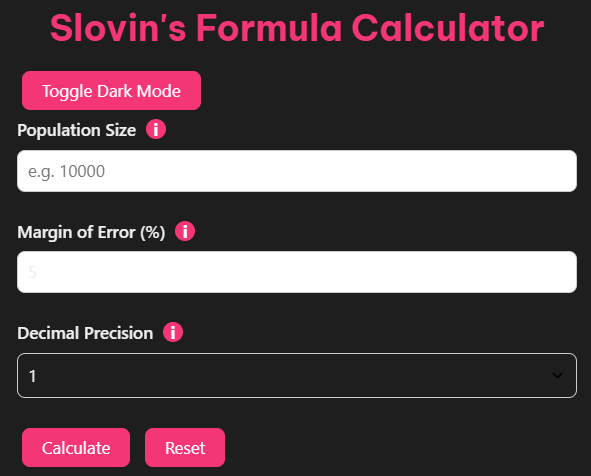Slovin's Formula Calculator
Sample Size: -
When conducting research, one of the most critical questions you’ll encounter is determining the ideal sample size for your study. This is where Slovin’s Formula plays an invaluable role. Researchers around the world rely on this simple yet effective tool to estimate sample sizes, ensuring accurate and actionable results.
Tip: Need a precise sample size formula? Use our Cochran Formula Calculator.
What Is Slovin’s Formula?
Slovin’s Formula is a mathematical equation used to calculate the sample size needed for a study, ensuring the results are statistically valid. It offers a quick and approximate way to determine the minimum sample size when you’re working The formula is expressed as:with a large population and a given margin of error.
“ n = N / (1 + N e²) “
Where:
- n = Required sample size
- N = Total population size
- e = Margin of error (expressed as a decimal)
Practical Application:
If you’re conducting a survey to understand consumer preferences in a city with a population of 500,000 and wish to maintain a 5% margin of error (e = 0.05), Slovin’s Formula will help you calculate the minimum number of respondents you need.
With the formula:
n = 500,000 / (1 + 500,000 0.05²)
n = 500,000 / (1 + 1,250)
n = 500,000 / 1,251
n ≈ 400
You’d need approximately 400 respondents for reliable results in this scenario.
How to Use Slovin’s Formula
Using Slovin’s Formula can seem daunting at first, but it’s quite straightforward when broken into steps:
Step-by-Step Guide:
- Identify Population Size (N): Start with the total size of the group you’re studying (e.g., city population or students at a university).
- Determine Your Margin of Error (e): Consider how much error you’re willing to allow in your sample. Commonly used margins are 5% (0.05) or 10% (0.10).
- Plug the Values into the Formula: Use the equation n = N / (1 + N * e²).
- Perform the Calculation: Solve for n to determine the required sample size.
Example 1: Understanding Student Opinions:
A university with 20,000 students is conducting research to measure satisfaction with canteen services, targeting a 5% margin of error:
n = 20,000 / (1 + 20,000 0.05²)
n = 20,000 / (1 + 50)
n = 20,000 / 51
n ≈ 392
The ideal sample size to survey is 392 students.
Example 2: Market Research for Product Launch:
A company launching a product in a market of 10,000 consumers wants to collect feedback with a 10% margin of error:
n = 10,000 / (1 + 10,000 0.10²)
n = 10,000 / (1 + 100)
n = 10,000 / 101
n ≈ 99
The company needs survey responses from at least 99 consumers.
Common Use Cases:
- Conducting population-based health studies.
- Academic research among university students.
- Marketing surveys for product research.
- Feedback collection among customers in retail businesses.
Advantages and Limitations of Slovin’s Formula
Advantages:
- Simplicity: Easy to use and quick; requires only basic population parameters.
- Accessibility: No need for complex software or advanced skills.
- Broad Utility: Useful for exploratory research or studies with limited preliminary data.
Limitations:
- Assumes Simple Random Sampling: Not ideal for stratified or clustered sampling.
- Ignores Population Variability: Does not factor in standard deviations or correlations within the data.
- Best for Basic Studies: Less robust than advanced methods like Cochran’s Formula or power analysis for complex research.
For high-stakes research requiring high precision, methods such as Raosoft Calculator or power analysis are better alternatives.
Example – Raosoft calculator:
Raosoft considers both population variability and the desired confidence level, making it suitable for formal and advanced studies.
Introducing our Free Slovin’s Formula Calculator 2025

While Slovin’s Formula is easy to use, manual calculations can sometimes lead to errors. That’s why we’ve developed the Free Slovin’s Formula Calculator, a tool designed to simplify your calculations and improve accuracy.
Features:
- User-Friendly Interface: Input population size and desired margin of error with ease.
- Instant Results: Get your sample size calculated in seconds.
- Adjustable Parameters: Experiment with different margins of error to see how it affects sample size.
- Mobile-Friendly Design: Use it on any device, from your phone to your desktop.
Example:
Suppose you’re researching 10,000 farmers in a region with a 5% margin of error. Simply enter:
- Population Size (N): 10,000
- Margin of Error (e): 5%
The calculator will do the math and display the result instantly as 385 respondents.
This saves you time and avoids the hassle of manual calculations.
Why Slovin’s Formula Is Still Relevant
Although limited in some statistical applications, Slovin’s Formula is invaluable for:
- Educational purposes, teaching the basics of sample size determination.
- Pilot or exploratory studies with limited resources.
- Quick estimations in scenarios where precision is not critical.
By simplifying research and providing a foundation for deeper analysis, Slovin’s Formula continues to be a powerful tool for researchers of all kinds.
With our Free Slovin’s Formula Calculator, anyone can harness this formula to kickstart their research projects effectively.
Try the Calculator Today and Simplify Your Research.